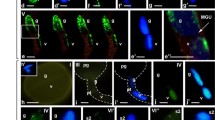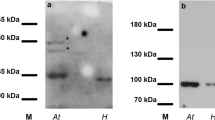Abstract
Pollen is required for fertilization and the associated production of seeds and fruits, which are important for human nutrition. Research on the tricellular pollen of Arabidopsis thaliana revealed that chromatin is highly condensed and transcriptional activity is suppressed in sperm cells. However, comprehensive structural investigations involving generative cells of bicellular pollen have not been conducted. In this study, we provide relevant insights into other angiosperms that produce bicellular pollen. Lilium longiflorum, which has large and easily observable nuclei, was used for a detailed analysis of the chromatin structure and transcriptionally active regions in pollen and pollen tubes. Chromatin was condensed, resulting in a ribbon-like structure that was clearly visible in mature generative cell nuclei. Additionally, transcriptionally active regions were restricted to the intersections of chromatin as pollen desiccated. Although de novo transcription was revealed to be unnecessary for pollen tube growth, transcriptional activity temporarily resumed before generative cell division during pollen tube growth. Moreover, the inhibition of de novo transcription influenced changes in nuclear morphology. In this study, the distinctive chromatin structures and transcriptional activity states in generative cell nuclei of bicellular pollen were elucidated, with the generated data contributing to a deeper understanding of transcription and other regulatory mechanisms involved in pollen maturation and pollen tube growth.






Similar content being viewed by others
Data availability
Data supporting the findings of this study are available from the corresponding author upon reasonable request.
References
Boavida LC, McCormick S (2007) TECHNICAL ADVANCE: temperature as a determinant factor for increased and reproducible in vitro pollen germination in Arabidopsis thaliana. Plant J 52:570–582. https://doi.org/10.1111/j.1365-313X.2007.03248.x
Borg M, Berger F (2015) Chromatin remodelling during male gametophyte development. Plant J 83:177–188. https://doi.org/10.1111/tpj.12856
Borg M, Buendía D, Berger F (2019) A simple and robust protocol for immunostaining Arabidopsis pollen nuclei. Plant Reprod 32:39–43. https://doi.org/10.1007/s00497-018-00360-7
Borg M, Jacob Y, Susaki D et al (2020) Targeted reprogramming of H3K27me3 resets epigenetic memory in plant paternal chromatin. Nat Cell Biol 22:621–629. https://doi.org/10.1038/s41556-020-0515-y
Borges F, Gomes G, Gardner R et al (2008) Comparative transcriptomics of Arabidopsis sperm cells. Plant Physiol 148:1168–1181. https://doi.org/10.1104/pp.108.125229
Brewbaker JL (1967) The distribution and phylogenetic significance of Binucleate and Trinucleate pollen grains in the angiosperms. Am J Bot 54:1069–1083. https://doi.org/10.1002/j.1537-2197.1967.tb10735.x
Buttress T, He S, Wang L, et al (2021) A histone variant condenses flowering plant sperm via chromatin phase separation. 2021.09.14.460326
Crowe JH, Hoekstra FA, Crowe LM (1992) Anhydrobiosis. Annu Rev Physiol 54:579–599. https://doi.org/10.1146/annurev.ph.54.030192.003051
Dumas C, Knox RB, Gaude T (1985) The spatial association of the sperm cells and vegetative nucleus in the pollen grain ofBrassica. Protoplasma 124:168–174. https://doi.org/10.1007/BF01290767
Engel ML, Holmes-Davis R, McCormick S (2005) Green sperm. Identification of male gamete promoters in Arabidopsis. Plant Physiol 138:2124–2133. https://doi.org/10.1104/pp.104.054213
Fernández P, Amice R, Bruy D et al (2024) A 160 Gbp fork fern genome shatters size record for eukaryotes. Science 27:8. https://doi.org/10.1016/j.isci.2024.109889
Glöckle B, Urban WJ, Nagahara S et al (2018) Pollen differentiation as well as pollen tube guidance and discharge are independent of the presence of gametes. Development 145:152645. https://doi.org/10.1242/dev.152645
Goto C, Tamura K, Fukao Y et al (2014) The novel nuclear envelope protein KAKU4 modulates nuclear morphology in Arabidopsis. Plant Cell 26:2143–2155. https://doi.org/10.1105/tpc.113.122168
Goto C, Tamura K, Nishimaki S et al (2020) The nuclear envelope protein KAKU4 determines the migration order of the vegetative nucleus and sperm cells in pollen tubes. J Exp Bot 71:6273–6281. https://doi.org/10.1093/jxb/eraa367
Hajheidari M, Koncz C, Eick D (2013) Emerging roles for RNA polymerase II CTD in Arabidopsis. Trends Plant Sci 18:633–643. https://doi.org/10.1016/j.tplants.2013.07.001
Hao H, Li Y, Hu Y, Lin J (2005) Inhibition of RNA and protein synthesis in pollen tube development of Pinus bungeana by actinomycin D and cycloheximide. New Phytol 165:721–730. https://doi.org/10.1111/j.1469-8137.2004.01290.x
Hara Y (2020) Specialization of nuclear membrane in eukaryotes. J Cell Sci 133:241869. https://doi.org/10.1242/jcs.241869
Harlen KM, Churchman LS (2017) The code and beyond: transcription regulation by the RNA polymerase II carboxy-terminal domain. Nat Rev Mol Cell Biol 18:263–273. https://doi.org/10.1038/nrm.2017.10
Hirsche J, García Fernández JM, Stabentheiner E et al (2017) Differential effects of carbohydrates on Arabidopsis pollen germination. Plant Cell Physiol 58:691–701. https://doi.org/10.1093/pcp/pcx020
Honys D, Twell D (2004) Transcriptome analysis of haploid male gametophyte development in Arabidopsis. Genome Biol 5:R85. https://doi.org/10.1186/gb-2004-5-11-r85
Ioannou D, Millan NM, Jordan E, Tempest HG (2017) A new model of sperm nuclear architecture following assessment of the organization of centromeres and telomeres in three-dimensions. Sci Rep 7:41585. https://doi.org/10.1038/srep41585
Johnson SA, McCormick S (2001) Pollen germinates precociously in the anthers of raring-to-go, an Arabidopsis gametophytic mutant. Plant Physiol 126:685–695. https://doi.org/10.1104/pp.126.2.685
Johnson MA, Harper JF, Palanivelu R (2019) A fruitful journey: pollen tube navigation from germination to fertilization. Annu Rev Plant Biol 70:809–837. https://doi.org/10.1146/annurev-arplant-050718-100133
Mascarenhas JP (1993) Molecular mechanisms of pollen tube growth and differentiation. Plant Cell 5:1303–1314. https://doi.org/10.2307/3869783
McCue AD, Cresti M, Feijó JA, Slotkin RK (2011) Cytoplasmic connection of sperm cells to the pollen vegetative cell nucleus: potential roles of the male germ unit revisited. J Exp Bot 62:1621–1631. https://doi.org/10.1093/jxb/err032
Mori T, Kuroiwa H, Higashiyama T, Kuroiwa T (2006) Generative cell specific 1 is essential for angiosperm fertilization. Nat Cell Biol 8:64–71. https://doi.org/10.1038/ncb1345
Motomura K, Takeuchi H, Notaguchi M et al (2021) Persistent directional growth capability in Arabidopsis thaliana pollen tubes after nuclear elimination from the apex. Nat Commun 12:2331. https://doi.org/10.1038/s41467-021-22661-8
Motomura K, Sugi N, Takeda A et al (2022) Possible molecular mechanisms of persistent pollen tube growth without de novo transcription. Front Plant Sci 13:8. https://doi.org/10.3389/fpls.2022.1020306
Okada T, Endo M, Singh MB, Bhalla PL (2005) Analysis of the histone H3 gene family in Arabidopsis and identification of the male-gamete-specific variant AtMGH3. Plant J 44:557–568. https://doi.org/10.1111/j.1365-313X.2005.02554.x
Renzaglia KS, Garbary DJ (2001) Motile gametes of land plants: diversity, development, and evolution. Crit Rev Plant Sci 20:107–213. https://doi.org/10.1080/20013591099209
Saito C, Nagata N, Sakai A et al (2002) Angiosperm species that produce sperm cell pairs or generative cells with polarized distribution of DNA-containing organelles. Sex Plant Reprod 15:167–178. https://doi.org/10.1007/s00497-002-0152-6
Schindelin J, Arganda-Carreras I, Frise E et al (2012) Fiji: an open-source platform for biological-image analysis. Nat Methods 9:676–682. https://doi.org/10.1038/nmeth.2019
Shibuta MK, Matsunaga S (2023) Transcriptionally active regions are highly limited in the nucleus of the plant sperm cell. Cytologia 88:273–279. https://doi.org/10.1508/cytologia.88.273
Shibuta MK, Sakamoto T, Yamaoka T et al (2021) A live imaging system to analyze spatiotemporal dynamics of RNA polymerase II modification in Arabidopsis thaliana. Commun Biol 4:1–10. https://doi.org/10.1038/s42003-021-02106-0
Takegami MH, Yoshioka M, Tanaka I, Ito M (1981) Characteristics of isolated microsporocytes from liliaceous plants for studies of the meiotic cell cycle in vitro. Plant Cell Physiol 22:1–10. https://doi.org/10.1093/oxfordjournals.pcp.a076135
Tanaka I (1991) Microtubule-determined plastid distribution during microsporogenesis in Lilium longiflorum. J Cell Sci 99:21–31. https://doi.org/10.1242/jcs.99.1.21
Vogler F, Konrad SSA, Sprunck S (2015) Knockin’ on pollen’s door: live cell imaging of early polarization events in germinating Arabidopsis pollen. Front Plant Sci 6:8. https://doi.org/10.3389/fpls.2015.00246
Voichek Y, Hurieva B, Michaud C et al (2024) Cell cycle status of male and female gametes during Arabidopsis reproduction. Plant Physiol 194:412–421. https://doi.org/10.1093/plphys/kiad512
von Besser K, Frank AC, Johnson MA, Preuss D (2006) Arabidopsis HAP2 ( GCS1) is a sperm-specific gene required for pollen tube guidance and fertilization. Development 133:4761–4769. https://doi.org/10.1242/dev.02683
Wang X, Li T, Xu J et al (2024) Distinct functions of microtubules and actin filaments in the transportation of the male germ unit in pollen. Nat Commun 15:5448. https://doi.org/10.1038/s41467-024-49323-9
Yang H, Yang N, Wang T (2016) Proteomic analysis reveals the differential histone programs between male germline cells and vegetative cells in Lilium davidii. Plant J 85:660–674. https://doi.org/10.1111/tpj.13133
Yu H-S, Hu S-Y, Zhu C (1989) Ultrastructure of sperm cells and the male germ unit in pollen tubes ofNicotiana tabacum. Protoplasma 152:29–36. https://doi.org/10.1007/BF01354237
Zhang J, Huang Q, Zhong S et al (2017) Sperm cells are passive cargo of the pollen tube in plant fertilization. Nat Plants 3:17079. https://doi.org/10.1038/nplants.2017.79
Acknowledgements
We are grateful to the Akita Prefectural Government and the Forestry Agency of Japan for granting permission and the Cultural Property Protection Office of Yuzawa city for providing support for the collection of K. japonica stamen. We also thank Prof. Dr. Jun Yokoyama and Mr. Masaki Sakaki for their assistance in collecting K. japonica stamen. We thank Prof. Dr. Yutaka Miyazawa and Prof. Dr. Yasushi Tamura for sharing equipment. We thank Edanz (https://jp.edanz.com/ac) for editing a draft of this manuscript. This research was supported by MEXT/JSPS KAKENHI (Grant Numbers 20K15836 and 23K14218), JST ACT-X (Grant Number JPMJAX22BB), and Nippon Genetics Co., Ltd.
Author information
Authors and Affiliations
Contributions
All authors contributed to the study conception and design as well as material preparation, data collection, and analysis. Mio K. Shibuta wrote the first draft of the manuscript, which was reviewed and revised by all authors. All authors read and approved the final manuscript.
Corresponding author
Ethics declarations
Competing interests
The authors declare no competing interests.
Additional information
Publisher's Note
Springer Nature remains neutral with regard to jurisdictional claims in published maps and institutional affiliations.
Supplementary Information
Below is the link to the electronic supplementary material.
Rights and permissions
Springer Nature or its licensor (e.g. a society or other partner) holds exclusive rights to this article under a publishing agreement with the author(s) or other rightsholder(s); author self-archiving of the accepted manuscript version of this article is solely governed by the terms of such publishing agreement and applicable law.
About this article
Cite this article
Shibuta, M.K., Aso, T. & Okawa, Y. Dynamic changes in chromatin structure and transcriptional activity in the generative cells of Lilium longiflorum. J Plant Res (2025). https://doi.org/10.1007/s10265-025-01637-5
Received:
Accepted:
Published:
DOI: https://doi.org/10.1007/s10265-025-01637-5




